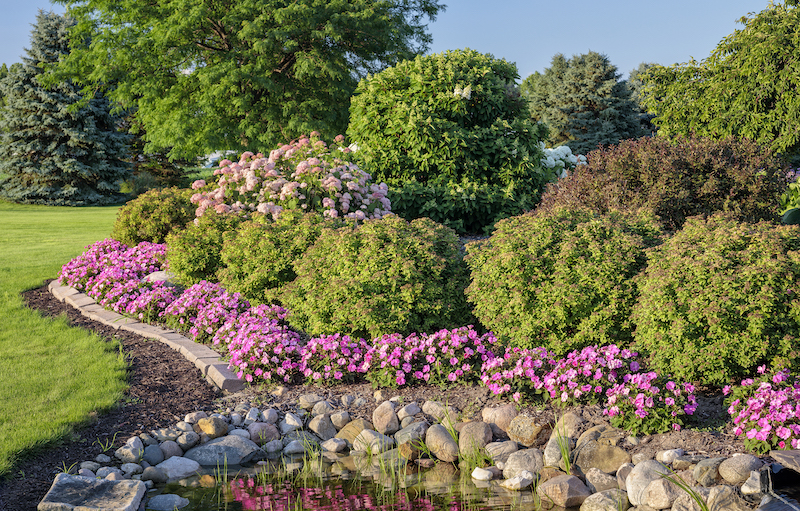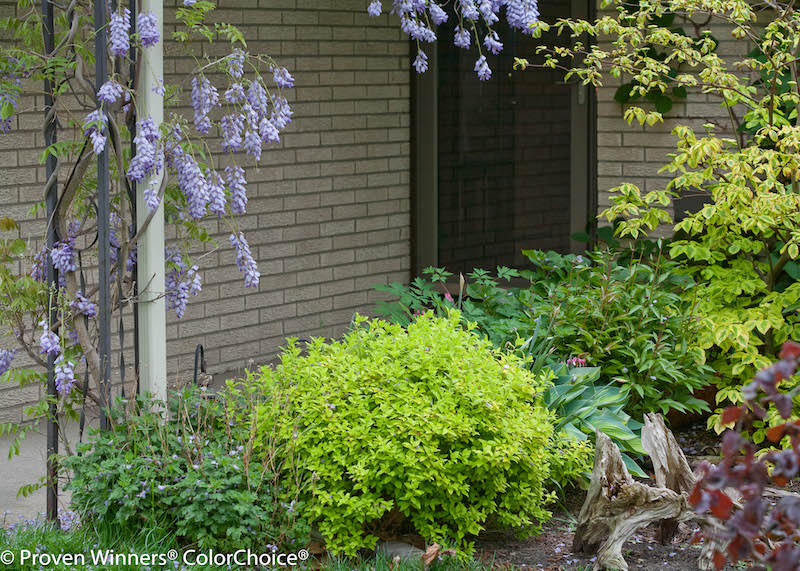The full, flowering form of spirea makes this low-maintenance deciduous shrub an eye-catching addition to an outdoor space. The lacy flower clusters can be white, pink, red, or mauve and stand out against the green, toothed foliage. Spirea grows in zones 4 through 8 and can be featured in a mixed bed, in a stunning flowering hedge, or as the main attraction in a butterfly garden.
Weigela, viburnum, loropetalum, low-growing junipers, and ornamental grasses grow well with spirea. When choosing companions, select plants that grow in the same climates and have similar sunlight and water needs. Spirea is adaptable, but this shrub prefers full to partial sun, well-drained soil and moderate moisture levels.

Shrubs To Plant With Spirea
Spirea is a woody shrub that can grow large, reaching several feet tall. Plant this shrub near other flowering shrubs to create a dense, low-maintenance, and showy mixed hedge or a unique border. Weigela, viburnum, loropetalum, and hydrangea are flowering shrubs that make excellent neighbors for spirea. All these shrubs feature spring or summer flowers in shades that complement the spirea’s blooms. The foliage provides a consistent green background, allowing the flowers to stand out.
Elderberry is a tree-like shrub favored by pollinators, while low-growing junipers fill in the ground surrounding the larger shrubs. The varying heights can work together to conceal a fence or outdoor utility box while creating a welcoming and vibrant space. Plant all three shrubs in full sun for best performance.

Perennials To Plant With Spirea
Spirea plants often stand several feet tall and wide. Tall ornamental grasses planted behind the shrub add height and movement, while ornamental alliums, dianthus and hostas can fill in the space at the front of a border. These perennials add color and texture, complementing spirea without competing with this shrub. Be sure to the give the hostas a little shade so the showy foliage doesn’t burn.

Annuals To Plant With Spirea
Begonias and impatiens grow well in the shade underneath a spirea. The pink, red, coral, white, or yellow flowers coordinate with the spirea’s blooms. Petunias are another annual that grows well underneath and surrounding spirea. The shrub creates enough shade to protect the delicate blooms, which are available in a wide selection of colors.
Best Companion Plants For Spirea in Containers
Lobelia is a good pick to feature in a planter around spirea. The pink, lilac, or white flowers coordinate with the foliage and flowers of spirea. Lobelia needs partial to full sun, which works well for spirea. Both plants grow well with nearby plants, and the lobelia will trail over the sides of the container for a soft look.
The low-growing sweet alyssum is another good candidate for a spirea container companion. The reaching stems, tiny leaves and 4-petaled flowers will spill over the edge of the container. Sweet alyssum blooms in the spring and reblooms in the fall, similar to the blooming schedule of various spirea cultivars.
Plants Not To Grow With Spirea
Plants that require full shade are a bad fit for a space shared with spirea plants. Deep shade will weaken the spirea and reduce blooming, so avoid pairing it with shade-loving ferns. Drainage is vital to spirea plants because while they have moderate water needs, they cannot grow in continuously damp soil, unlike canna, joe pye weed, and meadowsweet.
Best Plants To Grow With Spirea
The low-maintenance spirea provides colorful foliage and flowers and welcomes pollinators into a space. This shrub needs full to partial sun and well-drained soil. Companion plants must have similar care needs for a planting to thrive. Choose plants that bloom on a different timeline, like hydrangea, loropetalum, and weigela to enjoy blooms throughout the growing season. Plants like elderberry or low-growing juniper introduce different textures and heights for an outdoor space that looks professionally designed.
 |
Author Alison Cotsonas - Published 09-12-2023 |




